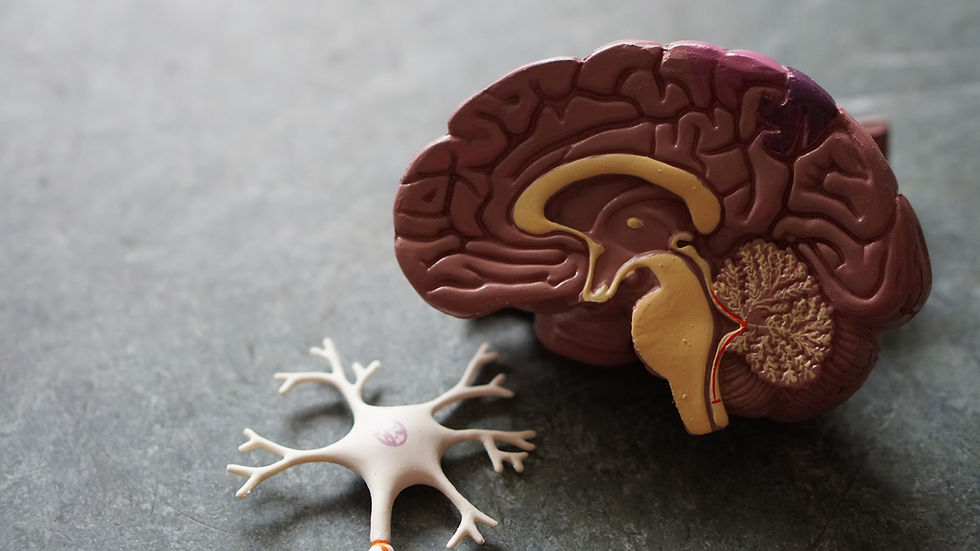How Can Visiting a Chiropractor Help Me?
- Marlborough Chiropractic Clinic

- Dec 31, 2024
- 4 min read
What is Pain?
Pain is not just a sensation, but a signal that something requires attention.
This alert system is part of the nervous system and uses pain receptors, known as nociceptors, to detect changes in the body. These nociceptors send signals to the brain where the signal is then converted to a pain sensation to inform us of the change. The signals can mean several things including:

A difference or deviation from the body's normal state, even if the change isn’t directly harmful yet. For example, muscle soreness after a new workout routine signals that the body is adapting to unusual exertion.
Too much pressure or stress; this can be physical or emotional;
Physical Pressure/Stress: Pain can arise from overstretched muscles, compressed nerves, or prolonged strains on a joint and the supporting ligaments.
Emotional/Stress-Induced Pain: Emotional stress can manifest physically, leading to tension headaches, chest pain, or stomach aches. This reflects how tightly interconnected mental and physical health are.
Pain is often the symptom that prompts the individual to address. This includes issues like back or neck pain, whether by seeking medical help or avoiding further harm. However, there can be other subtle indicators of dysfunction in the area long before it becomes painful such as: reduced motion, fatigue, poor sleep, falls, tripping or bumping into things, or reduction in strength.
Normal Function for Normal Movement and Activity
The musculoskeletal system is made up of joints, ligaments, muscles and long sheets of fascia.
Joints are the points where two or more bones meet, allowing movement and flexibility in the skeleton. For example, the knee joint enables bending and straightening of the leg.
Ligaments are the tough, fibrous tissues that connect bones to other bones, stabilising the joints and limiting excessive movement to prevent injury.
Muscles are tissues that contract and relax to produce movement. They attach to bones via tendons and work in tandem with joints and ligaments to facilitate smooth, controlled motion.
Fascia is a collagen-based tissue found throughout the body. It supports all structures, including muscles, bones, nerves, blood vessels, and organs. It plays an essential role in maintaining the body's structural integrity, facilitating movement, and supporting overall function.


All of these structures contain specialised receptors, which include proprioceptors (to help judge where your body part is) and mechanoreceptors, which provide information about the muscle and ligament movement.
The mechanoreceptors and proprioceptors send information to the brain, where the information processed to produce smooth, purposeful movements. The brain commands voluntary movements and interprets sensory feedback, whilst the spinal cord acts as a relay center, transmitting messages between the brain and body. This is how your brain ensures that muscles contract in sequence, joints move fluidly, and ligaments stabilise the joints when you walk, without you having to think about it.
How Function Becomes Dysfunction, and Dysfunction Becomes Injury
Dysfunction refers to impaired or abnormal function in any structure. Unlike acute injuries like ankle sprains, dysfunction in joints and ligaments often occurs gradually over a prolonged period of time. This sort of dysfunction may not produce any overt symptoms at first as the tissues begin to change in nature. We commonly see this presented as:
Over time poor posture can create stretch from which the ligament or muscle can no longer spring back. This weakens the tissue, makes the area unstable and reduces the tissue's ability to sense movement and balance, which increases instability and the chance of falls.
Altered forces on an area due to an unusual repetitive motion; compression forces create pressure on joints, triggering Wolff's Law. This is where the bone responds to the stress by adding more bone to an area, which leads to structural changes over time. This may then limit proper function or motion.
This subtle onset of dysfunction emphasises the importance of regular movement and attention to early warning signs like stiffness, reduced mobility, or altered balance and highlights the need for proactive care and awareness of body mechanics.
How Chiropractic Care Promotes Function
Chiropractic adjustments play a key role in improving the function and health of the nervous system and musculoskeletal system. This is achieved by several mechanisms:
Stimulating Fast-Track Movement nerves: Adjustments to target mechanoreceptors and proprioceptors in the joints. Stimulating these nerves wakes up the nerve pathways in the spinal cord and up to the brain. Activating these fast track nerves also inhibits and overrides the firing of the slower nerve pathways that carry the pain information
Stimulating the proprioceptors: Paired with activating the pathways leads to enhanced communication between the control centre of the brain and the joints, leading to quicker and more accurate responses to movement and surrounding environment creating stability and reducing the risk of falls and injuries.
Reducing Stiffness : Adjustments help to restore normal joint mobility by addressing restrictions in the joint capsules that may have developed due to poor posture, injury, or repetitive stress. Improved joint motion reduces stiffness, enhances flexibility, and decreases pain.

So why do patients come and see us regularly?
Having regular appointments with your chiropractor gives you the opportunity to have a health care practitioner regularly monitor and adjust subtle changes in your spine and the rest of your body, such as reduced joint movement or muscle tightness, before the area becomes painful or irritated.
Bergmann, T.F. and Peterson, D.H., 1993. Principles of the adjustive technique. In: T.F. Bergmann and D.H. Peterson, eds. Chiropractic Technique. 1st ed. Edinburgh: Churchill Livingstone, pp. 151.







Comments